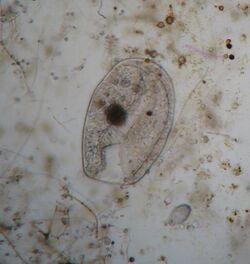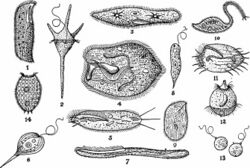Biology:Bursaria (ciliate)
| Bursaria | |
|---|---|

| |
| Bursaria ovata | |
| Scientific classification | |
| Domain: | |
| (unranked): | |
| (unranked): | Alveolata
|
| Phylum: | Ciliophora
|
| Class: | |
| Order: | Bursariomorphida
|
| Family: | Bursariidae
|
| Genus: | Bursaria O. F. Müller, 1773
|
Bursaria is a genus of ciliates in the class Colpodea. They are relatively large and feed on other protists in freshwater habitats.
Description
The cell body of Bursaria is scoop-shaped, and can be up to 1 mm long. Their oral region is crescent-shaped, and there is a band of membranelles (compound structures composed of multiple cilia) leading into the mouth. They live in the plankton of freshwater environments and ingest other protists, including algae and other ciliates.[1] Bursaria are the largest-sized colpodean ciliates.[2]
Systematics
Bursaria is the sole genus in the family Bursariidae.[2] The genus was originally described by O. F. Müller in 1773, with B. hirundinella as the type species.[3] It was formerly classified as a heterotrich, but is now classified as a member of the class Colpodea, based on the development of its oral structures (stomatogenesis) and its ultrastructure.[2]
References
- ↑ J., Patterson, David (2003). Free-living freshwater protozoa : a colour guide. Hedley, Stuart.. Washington, DC: ASM Press. ISBN 9781555812751. OCLC 56025552. https://www.worldcat.org/oclc/56025552.
- ↑ 2.0 2.1 2.2 Lynn, Denis H. (2008). The ciliated protozoa : characterization, classification, and guide to the literature. New York: Springer. ISBN 9781402082382. OCLC 272311632. https://www.worldcat.org/oclc/272311632.
- ↑ "Bursaria hirundinella O.F.Müller :: Algaebase". http://www.algaebase.org/search/species/detail/?species_id=F21553e6027b340d0&sk=0&from=results.
External links
Wikidata ☰ Q46674974 entry
 |


